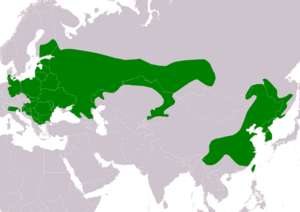Striped field mouse facts for kids
Quick facts for kids Striped field mouse |
|
|---|---|
 |
|
| Conservation status | |
| Scientific classification | |
| Genus: |
Apodemus
|
| Species: |
agrarius
|
 |
|
| Range of A. agrarius Resident | |
| Synonyms | |
|
|
|
The striped field mouse (Apodemus agrarius) is a small rodent that belongs to the Muridae family, which includes many types of mice and rats. These mice are known for the dark stripe running down their back. You can find them living across a huge area, from Eastern Europe all the way to Eastern Asia.
Contents
What Does a Striped Field Mouse Look Like?
Striped field mice have fur that is grayish-brown on their upper body, often with a hint of rusty color. The most noticeable feature is a clear black stripe that goes down the middle of their back. Their belly fur is lighter and grayish. They have fairly small ears and eyes compared to some other mice.
An adult striped field mouse can grow up to about 12.6 centimeters (about 5 inches) long, not including its tail. Their tail can be up to 9 centimeters (about 3.5 inches) long. These little creatures usually weigh up to 50 grams, which is about the same as a small apple.
Where Do Striped Field Mice Live?
The striped field mouse lives in a very wide area, but their homes are not always connected. Their range is split into two main parts.
European and Asian Homes
One part of their home range stretches from central and eastern Europe. It goes north towards Lake Baikal in Russia and south into China. The other part includes areas in the Russian Far East, and from there, it reaches into Mongolia and even Japan.
These mice seem to have moved into Eastern Europe more recently. For example, they are thought to have arrived in Austria in the 1990s.
Favorite Habitats
Striped field mice are very adaptable and can live in many different places. You might find them at the edges of forests, in grassy fields, or near wet areas like marshes. They also live in pastures, gardens, and even in cities. When winter comes and it gets cold, they sometimes move into haystacks, storage buildings, or even people's homes to stay warm.
What Do Striped Field Mice Eat and How Do They Live?
Striped field mice are busy little animals. They dig short burrows underground, which have a special chamber for their nest.
Daily Habits
During the summer, these mice are mostly active at night. But when winter arrives, they switch their schedule and are more active during the day.
What's on the Menu?
Their diet changes depending on what food is available. They eat many different things, including:
- Green parts of plants
- Roots
- Seeds
- Berries
- Nuts
- Insects
Reproduction and Life Cycle
Striped field mice can have many babies! A female mouse can have three to five litters (groups of babies) in a single year. On average, each litter has about six young mice. This means their population can grow very quickly when conditions are good.
However, some things can limit how many mice there are. Heavy rains during warm seasons, early freezing of the ground, and predators (animals that hunt them) can all reduce their numbers.
How Do Striped Field Mice Interact with People?
Because striped field mice are so common and can have many babies, they are sometimes seen as pests, especially in farming areas. When their population grows very large, they can cause damage to crops.
They can also carry diseases that are common in rodents.
See also
- List of mammals of Korea
- List of mammals of Russia
- List of mammals of China
- List of mammals of Ukraine
- List of mammals of Belarus
- List of mammals of Lithuania
- List of mammals of Latvia
- List of mammals of Estonia
- List of mammals of Finland
- List of mammals of Poland
- List of mammals of Germany
- List of mammals of Hungary
- List of mammals of Romania


